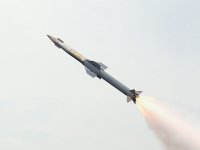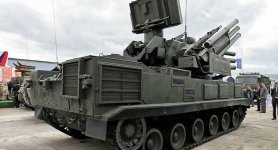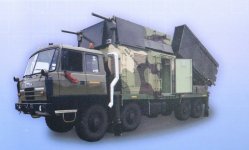Akash Series Surface to Air Missile System
- Thread starter Aashish
- Start date
You are using an out of date browser. It may not display this or other websites correctly.
You should upgrade or use an alternative browser.
You should upgrade or use an alternative browser.
Posting his full article here for other members to read. He genuinely looks very knowledgeable
@randomradio
@nair
@Gautam
@Sathya
@Millspec
AKASH-NG

In Jan 2021, India tested its brand new Akash NG (New Generation) program. Name apart, this is a radically new system which overhauls the entire Akash architecture and has little resemblance to its predecessor. It offers the IAF a totally Indian replacement for the MRSAM joint venture (Barak-8 being the purely Israeli variant). The MRSAM depends on a high degree of imported subsystems like its radar and seeker, which can't be rapidly reconfigured without Israeli involvement. Judging by its revealed architecture and system details, the Akash NG will likely have equivalent or even better performance than the MRSAM. As can be expected, IAF representatives were present during the trial. The Akash NG features DRDO's dual pulse rocket motor too, a powerful seeker (approximately 2x the performance of that on the Astra Mk1, QRSAM), and is specifically tailored for low Radar Cross Section threats. The threat class also indicates it will field DRDO's new laser fuse. Intercepting highly maneuvering targets is where the Dual Pulse motor will be particularly useful. The seeker can target velocities up to the SRBM class clearly indicating a limited TMD role, similar to that of the Barak-8. Considering a missile/ rocket barrage is an increasing threat for many forward IAF bases, this is a useful capability to have.
Unlike the MRSAM, this is not a vertical launch system. There are tradeoffs here. On the one hand the missile need not carry excess weight in the form of thrust vector control or a nose cone with motors to slew it (Brahmos style, and which would impede lock on before launch), implying better range. A slant /turntable mechanism would give it better reaction times too. However dealing with multi axis surge attacks would be a challenge unless DRDO had each launcher address a sector independently. This is exactly what they have done.
done.

Take a quick look at the image above after reading the press release. What you see is India's first combined Radar and Launcher setup beyond the short range Trishul program. The image clearly shows a 4 panel AESA Multi Function radar setup, similar to that developed for the QRSAM program.
Towards the rear, behind the initial smoke plume, you can see another slanted panel. So 360 degree coverage, with the thinner strip panels for IFF. The radar in all likelihood will be more powerful than that on the QRSAM. It has to be, as the Akash NGs envelope will be around 2.5-3x that of the QRSAM’s. The radar has to look and guide further.
In short, unless this is a test setup alone (which doesn't seem likely, why go to all that trouble for this configuration) each Akash NG can have an independent battery by itself, mobile and lethal. It can relocate on its own and unlike comparable Russian systems, the radar is fully multi-function with limited dependence on its Surveillance Radar beyond Early Warning. It is also AESA, something the Russians are yet to broadbase on their SAM systems.
Given the radars capacity, it wouldn't be beyond DRDO to pair this radar with independent launchers too. They'd complement the units with the radar-missile mix. Perhaps, operating as launchers plus loaders with spare missiles.
All in all, there are many interesting possibilities in play if DRDO chooses to go ahead with this configuration.
We can also expect future variants of this radar to have an EO pod with a long range thermal Imager, day camera and a long range laser finder as a back up to the radar allowing it to mount nearly undetectable attacks (very few fighters have laser warning systems). Again, similar to the QRSAM system.
While colocating the radar and missiles may open up their vulnerability to Anti Radiation Missiles, these are AESA systems, not easy to track or counter. Remote operation would be possible and knocking out a radar merely takes one launcher off the table. In the MRSAM architecture, unless there are backups, the single radar is the key FCR for its launchers. With the Akash NG, targeting a single radar is not enough to shut down a multi-launcher threat, each with its own sensors.
In short, this is a much more lethal system. And all this in a compact footprint as DRDO notes.

In the next iteration we will likely see the Akash NGs AESA Based long range surveillance radar too. Via a command post the whole setup will be linked to the IAFs IACCS, with engagement efficacy being dramatically boosted by access to the IAFs wider sensor network.
Overall, the Akash NG program offers India a very capable and credible alternative to reliance on imported systems, which come with more restrictions and can't be rapidly reconfigured to Indian requirements. The IAF would be well served to induct it, and have DRDO develop more variants for enhanced range profiles and threat classes.

Last edited:
Posting his full article here for other members to read. He genuinely looks very knowledgeable
@randomradio
@nair
@Gautam
@Sathya
@Millspec
Quite a bit of speculation though. Only some of the info there has been verified. The TELAR capability is also speculation right now.
It looks like it can be used as standalone systems with Missile, Radar and command systems integrated into the same vehicle.Quite a bit of speculation though. Only some of the info there has been verified. The TELAR capability is also speculation right now.
Have a look at test vehicle.
BTW disappointed to know that it’s not a vertically launched system
And his suggestion for EO sensors and Laser finder is also fascinating for setting up Ambush for hostile enemy jets
Last edited:
It looks like it can be used as standalone systems with Missile, Radar and command systems integrated into the same vehicle.
Have a look at test vehicle.
Yeah, but we need to see the front and back before it can be fully verified. Right now, from the distance, it looks like there's only a grill and what looks like a large IFF. That shape is not suitable for target acquisition anyway.
Also, for MRSAM like capability, you need a very large radar, at least 3mx2m in the S band. Look at the size of the radar needed for MRSAM.

For MRSAM capability, you need to be able to see targets from 250+Km away, while being able to engage them from 100+Km.
One can speculate that the Akash NG battery will have such a large radar if MRSAM capability is required, but then that defeats the purpose of the TELAR capability. Why have more radars when one such radar is enough? THe MRSAM does not need a separate surveillance radar and a separate targeting radar. Another option is to have a 2mx2m X band radar or even 1mx1m X band and completely cut out the large radar. But we need to be able to see such a radar, which is obviously not on the side that's visible.
Expecting the Akash NG to have MRSAM capabilities is merely speculation. DRDO claims that the Akash NG is meant to fit in the gap between LLQRM and MRSAM. It's basically meant to be an SRSAM that can also engage targets at very high altitude, which the SRSAMs that we operate (SPYDER-SR) cannot do. Hence its being advertised as a 50Km missile. Common sense says DRDO is not creating a duplicate of the MRSAM.
The way I see it, it's basically a TEL, with a very small truck carrying a very large power generator. At best, it's possibly carrying some secondary sensors, like the IFF or IFF/datalink combo.
Basically, MRSAM capability + TELAR = Impossible. Even if it can be done, it will be prohibitively expensive, with the radar alone costing much more than the missile load it's carrying. It will basically have to be like a fighter jet radar, and you need multiple faces for 360 deg capability, so you can imagine the cost of each TELAR.
SRSAM + TELAR = Depends on what's in the front, but it's possible since the radar is expected to function only up to 100Km, no different from the QRSAM. But the QRSAM has been designed that way because it needs to protect armour, which is not expected out of Akash NG.
The article contradicts with common sense. We need a whole lot more information.
Akash NG is not a MRSAM that is sure and will definitely need a bigger radar at higher elevation to be used as MRSAM.Yeah, but we need to see the front and back before it can be fully verified. Right now, from the distance, it looks like there's only a grill and what looks like a large IFF. That shape is not suitable for target acquisition anyway.
Also, for MRSAM like capability, you need a very large radar, at least 3mx2m in the S band. Look at the size of the radar needed for MRSAM.

For MRSAM capability, you need to be able to see targets from 250+Km away, while being able to engage them from 100+Km.
One can speculate that the Akash NG battery will have such a large radar if MRSAM capability is required, but then that defeats the purpose of the TELAR capability. Why have more radars when one such radar is enough? THe MRSAM does not need a separate surveillance radar and a separate targeting radar. Another option is to have a 2mx2m X band radar or even 1mx1m X band and completely cut out the large radar. But we need to be able to see such a radar, which is obviously not on the side that's visible.
Expecting the Akash NG to have MRSAM capabilities is merely speculation. DRDO claims that the Akash NG is meant to fit in the gap between LLQRM and MRSAM. It's basically meant to be an SRSAM that can also engage targets at very high altitude, which the SRSAMs that we operate (SPYDER-SR) cannot do. Hence its being advertised as a 50Km missile. Common sense says DRDO is not creating a duplicate of the MRSAM.
The way I see it, it's basically a TEL, with a very small truck carrying a very large power generator. At best, it's possibly carrying some secondary sensors, like the IFF or IFF/datalink combo.
Basically, MRSAM capability + TELAR = Impossible. Even if it can be done, it will be prohibitively expensive, with the radar alone costing much more than the missile load it's carrying. It will basically have to be like a fighter jet radar, and you need multiple faces for 360 deg capability, so you can imagine the cost of each TELAR.
SRSAM + TELAR = Depends on what's in the front, but it's possible since the radar is expected to function only up to 100Km, no different from the QRSAM. But the QRSAM has been designed that way because it needs to protect armour, which is not expected out of Akash NG.
The article contradicts with common sense. We need a whole lot more information.
Isn’t it meant to be a SHORAD only ?
I did a quick google and find following results for SHORAD
US
SHORAD

IM-SHORAD (Leonardo)

China


Russian SOSNA

pantsir s1m

Tor M1

RBS 98

Hisar A turkey

All of these are compact standalone systems designed for quick deployment.
So I don’t think why DRDO can’t do the same.
Also don’t understand why so many types of Shoret range ADS developed by Russia. While USA has hardly anything except limited capability SHORAD.
Attachments
Last edited:
Akash NG is not a MRSAM that is sure and will definitely need a bigger radar at higher elevation to be used as MRSAM.
Isn’t it meant to be a SHORAD only ?
I did a quick google and find following results for SHORAD
US
SHORAD
View attachment 19606
IM-SHORAD (Leonardo)
View attachment 19609
China
View attachment 19607View attachment 19608
Russian SOSNA
View attachment 19610
pantsir s1m
View attachment 19612
Tor M1
View attachment 19613
RBS 98
View attachment 19614
Hisar A turkey
View attachment 19615
All of these are compact standalone systems designed for quick deployment.
So I don’t think why DRDO can’t do the same.
The article claims it's a TELAR + MRSAM. I'm saying there's zero information confirming the same with just the pic.
It has nothing to do with whether DRDO can develop it or not, it simply has to do with design choices. With a single radar, you get more capability than you get using TELAR. But TELAR has greater survivability. So do you want greater capability or greater survivability? This is something only the forces can decide after years and years of planning and exercises.
Akash NG is meant for the air force. It's not a SHORAD since it is also meant to engage targets at high altitudes, no different from Akash Mk1. so it is an "MRSAM". I'll explain below.
SHORAD, SRSAM, QRSAM, LLQRM etc are all basically for similar type of SAM systems. Plus different forces have different designations, even within the same country. For example, the IAF calls Akash Mk1 as MRSAM and IA calls it SRSAM. So the IAF has two MRSAMs, and Akash NG will make it their third MRSAM, but neither of the Akash SAMs are the same as the Israeli MRSAM, which is obviously in a different class, but all three are capable of bringing down targets at high altitude, hence the designation of MRSAM. IAF's LRSAM would be called XRSAM, whereas the IN calls the Barak as LRSAM. Welcome to semantics.
The article itself is all over the place because it's giving false equivalence to the definition of "MRSAM" by linking it to the Indo-Israeli MRSAM. There could be internal designations for the three different MRSAMs, but that's obviously going to be out of the scope of public knowledge and is irrelevant to us. It will get easier once the Indo-Israeli MRSAM gets a name.
Also don’t understand why so many types of Shoret range ADS developed by Russia. While USA has hardly anything except limited capability SHORAD.
The US didn't pay much attention to their LOMAD capability after the end of the Cold War. They did not have any challenge from the air after all. They are picking up the slack now, with multiple programs, including DEW. Russian action in Syria woke them up.
Doctrinal differences.Also don’t understand why so many types of Shoret range ADS developed by Russia. While USA has hardly anything except limited capability SHORAD.
are these machinery imported from west, or built in house ?
Interesting that there is no press release.

 timesofindia.indiatimes.com
timesofindia.indiatimes.com

Upgraded Akash missile test fired in Jaisalmer dist | Jaipur News - Times of India
Jaisalmer: The Indian Army and Defence Research and Development Organisation (DRDO) on Tuesday successfully conducted the launch of the new generation.
The radio characterization unit is probably from Honeywell. The rest is built in house.are these machinery imported from west, or built in house ?
DRDO successfully flight-tests surface-to-air missile Akash-NG
New Generation surface-to-air Missile High manoeuvrability to neutralise aerial threats Boost
 pib.gov.in
pib.gov.in
Defence Research & Development Organisation (DRDO) successfully flight-tested the New Generation Akash Missile (Akash-NG), a surface-to-air Missile from Integrated Test Range (ITR) off the coast of Odisha on July 21, 2021. The flight trial was conducted at around 12:45 PM from a land-based platform with all weapon system elements such as Multifunction Radar, Command, Control & Communication System and launcher participating in deployment configuration.
The missile system has been developed by Defence Research & Development Laboratory (DRDL), Hyderabad in collaboration with other DRDO laboratories. The launch was witnessed by the representatives of Indian Air Force. In order to capture flight data, ITR deployed a number of Range stations like, Electro Optical Tracking System, Radar and Telemetry. The flawless performance of the entire weapon system has been confirmed by complete flight data captured by these systems. During the test, the missile demonstrated high manoeuvrability required for neutralising fast and agile aerial threats.
Once deployed, the Akash-NG weapon system will prove to be a force multiplier for the air defence capability of the Indian Air Force. Production agencies Bharat Electronics Limited (BEL) and Bharat Dynamics Limited (BDL) also participated in the trials.
Raksha Mantri Shri Rajnath Singh has congratulated DRDO, BDL, BEL, Indian Air Force and the Industry for the successful test. Secretary Department of Defence R&D and Chairman DRDO applauded the efforts of the team and said the missile will strengthen the Indian Air Force.
We are slowly getting confirmation that the Akash launcher also has a TELAR configuration, not just a TEL configuration. Probably doesn't even have a TEL.
It was speculated to be a TELAR earlier, but we didn't see the side radars. Now we need to see if it has a radar at the back as well.
It looks like answers are coming.






